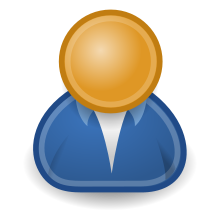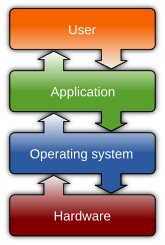User (computing)

| Operating systems |
|---|
 |
| Common features |
Auseris a person who utilizes acomputerornetworkservice. A user often has auser accountand is identified to the system by ausername(oruser name).[a] Some software products provide services to other systems and have no directend users.
End user
End usersare the ultimate human users (also referred to asoperators) of a software product. The end user stands in contrast to users who support or maintain the product such assysops,database administratorsandcomputer technicians.The term is used to abstract and distinguish those who only use the software from the developers of the system, who enhance the software for end users.[1]Inuser-centered design,it also distinguishes the software operator from the client who pays for its development and otherstakeholderswho may not directly use the software, but help establish itsrequirements.[2][3]This abstraction is primarily useful in designing theuser interface,and refers to a relevant subset of characteristics that most expected users would have in common.
In user-centered design,personasare created to represent the types of users. It is sometimes specified for each persona which types of user interfaces it is comfortable with (due to previous experience or the interface's inherent simplicity), and what technical expertise and degree of knowledge it has in specific fields ordisciplines.When few constraints are imposed on the end-user category, especially when designing programs for use by the general public, it is common practice to expect minimal technical expertise or previous training in end users.[4]
Theend-user developmentdiscipline blurs the typical distinction between users and developers. It designates activities or techniques in which people who are not professional developers create automated behavior and complex data objects without significant knowledge of a programming language.
Systems whoseactoris another system or asoftware agenthave no direct end users.
User account
A user's account allows a user toauthenticateto a system and potentially to receiveauthorizationtoaccessresources provided by or connected to that system; however, authentication does not imply authorization. To log into an account, a user is typically required toauthenticateoneself with apasswordor othercredentialsfor the purposes ofaccounting,security,logging, andresource management.
Once the user has logged on, the operating system will often use an identifier such as an integer to refer to them, rather than their username, through a process known asidentity correlation.InUnixsystems, the username is correlated with auser identifieroruser ID.
Computer systems operate in one of two types based on what kind of users they have:
- Single-user systems do not have a concept of several user accounts.
- Multi-usersystems have such a concept, and require users to identify themselves before using the system.
Each user account on a multi-user system typically has ahome directory,in which to storefilespertaining exclusively to that user's activities, which is protected from access by other users (though asystem administratormay have access). User accounts often contain a publicuser profile,which contains basic information provided by the account's owner. The files stored in the home directory (and all other directories in the system) have file system permissions which are inspected by theoperating systemto determine which users are granted access to read or execute a file, or to store a new file in that directory.
While systems expect most user accounts to be used by only a single person, many systems have a special account intended to allow anyone to use the system, such as the username "anonymous" foranonymous FTPand the username "guest" for a guest account.
Password storage
OnUnixsystems, local user accounts are stored in the file/etc/passwd,while user passwords may be stored at/etc/shadowin itshashedform.[5]
OnMicrosoft Windows,user passwords can be managed within the Credential Manager program.[6][better source needed]The passwords are located in the Windows profile directory.[7]
Username format
Various computer operating-systems and applications expect/enforce different rules for the format.
InMicrosoft Windowsenvironments, for example, note the potential use of:[8]
- User Principal Name (UPN) format – for example: UserName@Example
- Down-Level Logon Name format – for example: DOMAIN\UserName
Terminology
Some usability professionals have expressed their dislike of the term "user" and have proposed changing it.[9]Don Normanstated that "One of the horrible words we use is 'users'. I am on a crusade to get rid of the word 'users'. I would prefer to call them 'people'."[10]
The term "user" may imply lack of the technical expertise required to fully understand how computer systems and software products work.[11]Power usersuse advanced features of programs, though they are not necessarily capable ofcomputer programmingandsystem administration.[12][13]
See also
- 1% rule (Internet culture)
- Anonymous post
- Prosumer
- Pseudonym
- End-user computing,systems in which non-programmers can create working applications.
- End-user database,a collection of data developed by individual end-users.
- End-user development,a technique that allows people who are not professional developers to perform programming tasks, i.e. to create or modify software.
- End-user license agreement(EULA), a contract between a supplier of software and its purchaser, granting the right to use it.
- Luser
- Namechk
- Nickname
- Registered user
- User error
- User agent
- User experience
- User space
Notes
- ^Other terms for username includelogin name,screenname(orscreen name),account name,nickname(ornick) andhandle,which is derived from the identicalcitizens band radioterm.[citation needed]
References
- ^Ko, Andrew J.; Abraham, Robin; Beckwith, Laura; Blackwell, Alan; Burnett, Margaret; Erwig, Martin; Scaffidi, Chris; Lawrance, Joseph; Lieberman, Henry; Myers, Brad; Rosson, Mary Beth; Rothermel, Gregg; Shaw, Mary; Wiedenbeck, Susan (April 2011)."The State of the Art in End-User Software Engineering"(PDF).ACM Computing Surveys.43(3): 1–44.doi:10.1145/1922649.1922658.S2CID9435548.Archived(PDF)from the original on 1 April 2011.
- ^"Understanding Organizational Stakeholders for Design Success".2004-05-06.Retrieved2016-08-31.
- ^Rigsbee, Sarah, and William B. Fitzpatrick. "User-Centered Design: A Case Study on Its Application to the Tactical Tomahawk Weapons Control System.Archived2017-10-14 at theWayback Machine"Johns Hopkins APL Technical Digest31.1 (2012): 76–82.
- ^"What is end user?".September 1996.RetrievedNovember 7,2010.
- ^"What is /etc/passwd and /etc/shadow files".7 March 2021.
- ^"[Solved] Where Are Passwords Stored in Windows 10/11".
- ^"Password Storage Locations For Popular Windows Applications".
- ^
"User Name Formats".MSDN.Developer technologies. Microsoft.Retrieved2016-01-11.
The down-level logon name format is used to specify adomainand a user account in that domain [...].
- ^Don Norman (17 November 2008)."Words Matter. Talk About People: Not Customers, Not Consumers, Not Users".
- ^"Don Norman at UX Week 2008 © Adaptive Path".YouTube.Archivedfrom the original on 2021-12-21.Retrieved8 November2010.
- ^Jargon Fileentry for"User".RetrievedNovember 7,2010.
- ^"Power Users' Guide".SAP Help Portal.Archivedfrom the original on Jun 27, 2015.Retrieved2015-01-14.
- ^Chen, Raymond (Feb 2012)."Windows Confidential: Power to the Power User".Microsoft.Archivedfrom the original on Apr 4, 2015.Retrieved2015-01-14.
